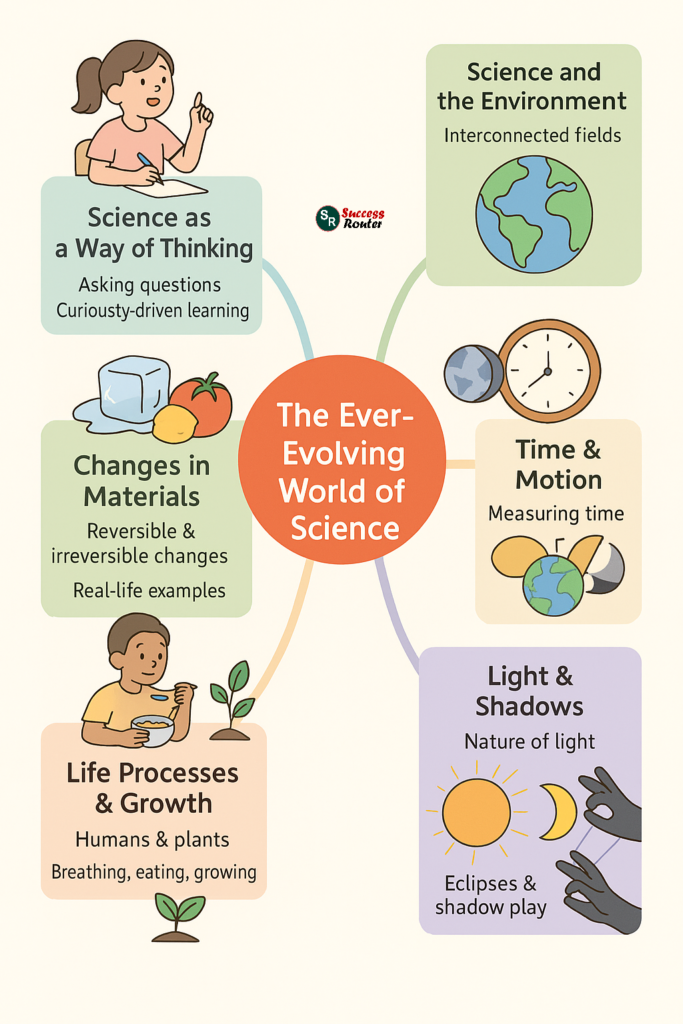Last Updated on May 2, 2025 by XAM CONTENT
Hello students, we are providing assertion reason questions for class 7 science (Curiosity). Assertion reason questions are the new question format that is introduced in CBSE board. The resources for assertion reason questions are very less. So, to help students we have created chapterwise assertion reason questions for class 7 science. In this article, you will find assertion reason questions for CBSE Class 7 Science Chapter 1 The Ever-Evolving World of Science.
The NCERT Curiosity Science textbook for Class 7, developed as per the latest National Education Policy (NEP) 2020, is a fresh and engaging resource for young learners. Titled “Curiosity: Textbook of Science for Grade 7”, this new Class 7 Science book includes 12 thoughtfully designed chapters. Each chapter encourages students to explore real-world scientific concepts, develop critical thinking, and spark curiosity through hands-on experiences and relatable content. With its learner-centric approach, the Curiosity textbook aims to connect students with the world around them and inspire a lifelong love for science.
| Chapter | The Ever-Evolving World of Science |
| Book | Curiosity: Textbook of Science for Grade 7 |
| Type of Questions | Assertion Reason Questions |
| Nature of Questions | Competency Based Questions |
| Board | CBSE |
| Class | 7 |
| Subject | Science |
| Useful for | Class 7 Studying Students |
| Answers provided | Yes |
| Difficulty level | Mentioned |
| Important Link | Class 7 Science Chapterwise Assertion Reason |
Assertion Reason Questions on The Ever-Evolving World of Science
Assertion Reason Questions
Q1. Assertion (A): Scientific exploration often leads to more questions rather than just final answers.
Reason (R): In science, every discovery is considered the end of learning.
(a) Both A and R are true, and R is the correct explanation of A.
(b) Both A and R are true, but R is not the correct explanation of A.
(c) A is true, but R is false.
(d) A is false, and R is also false.
Answer: (c) A is true, but R is false.
Explanation: Scientific exploration encourages continuous questioning and deeper inquiry; it never signifies the end of learning.
Difficulty Level: Moderate
Q2. Assertion (A): Early observations of bird wings and paper planes contributed to the development of real aircrafts.
Reason (R): Curiosity and simple experiments have historically driven major technological innovations.
(a) Both A and R are true, and R is the correct explanation of A.
(b) Both A and R are true, but R is not the correct explanation of A.
(c) A is true, but R is false.
(d) A is false, and R is also false.
Answer: (a) Both A and R are true, and R is the correct explanation of A.
Explanation: Early inspirations from natural observations (like bird wings) and simple experiments (like paper planes) led to advances in real aviation.
Difficulty Level: Moderate
Q3. Assertion (A): The interconnectedness of different fields of science allows discoveries in one area to inspire questions in another.
Reason (R): Chemistry and biology are completely independent fields with no overlap.
(a) Both A and R are true, and R is the correct explanation of A.
(b) Both A and R are true, but R is not the correct explanation of A.
(c) A is true, but R is false.
(d) A is false, and R is also false.
Answer: (c) A is true, but R is false.
Explanation: Different branches of science are interconnected; for example, chemical processes are vital to biological systems.
Difficulty Level: Tough
Q4. Assertion (A): Understanding scientific processes also helps students become more responsible towards environmental challenges.
Reason (R): Scientific learning makes students focus only on technological innovations, ignoring the environment.
(a) Both A and R are true, and R is the correct explanation of A.
(b) Both A and R are true, but R is not the correct explanation of A.
(c) A is true, but R is false.
(d) A is false, and R is also false.
Answer: (c) A is true, but R is false.
Explanation: Scientific learning develops responsibility towards sustainable practices, not just technological advancement.
Difficulty Level: Moderate
Q5. Assertion (A): Observations like the movement of shadows helped early humans develop timekeeping devices.
Reason (R): Early humans understood that light and shadow patterns could predict the weather conditions.
(a) Both A and R are true, and R is the correct explanation of A.
(b) Both A and R are true, but R is not the correct explanation of A.
(c) A is true, but R is false.
(d) A is false, and R is also false.
Answer: (c) A is true, but R is false.
Explanation: Movement of shadows was mainly used for measuring time, not for weather prediction.
Difficulty Level: Moderate/Tough
Also check
- Curiosity Class 7 Science Chapter 12 Earth, Moon, and the Sun Assertion Reason Questions
- Curiosity Class 7 Science Chapter 11 Light: Shadows and Reflections Assertion Reason Questions
- Curiosity Class 7 Science Chapter 10 Life Processes in Plants Assertion Reason Questions
- Curiosity Class 7 Science Chapter 9 Life Processes in Animals Assertion Reason Questions
- Curiosity Class 7 Science Chapter 8 Measurement of Time and Motion Assertion Reason Questions
- Curiosity Class 7 Science Chapter 7 Heat Transfer in Nature Assertion Reason Questions
- Curiosity Class 7 Science Chapter 6 Adolescence: A Stage of Growth and Change Assertion Reason Questions
- Curiosity Class 7 Science Chapter 5 Changes Around Us: Physical and Chemical Assertion Reason Questions
- Curiosity Class 7 Science Chapter 4 The World of Metals and Non-metals Assertion Reason Questions
- Curiosity Class 7 Science Chapter 3 Electricity: Circuits and their Components Assertion Reason Questions
- Curiosity Class 7 Science Chapter 2 Exploring Substances: Acidic, Basic, and Neutral Assertion Reason Questions
- Curiosity Class 7 Science Chapter 1 The Ever-Evolving World of Science Assertion Reason Questions
🚀 Boost Your Exam Prep: Get assertion reason questions for all subjects (Class 6-12) now!
👉 Explore more resources on CBSE Class 7
Topics from which assertion reason questions may be asked
- Science in daily life
- Scientific inventions
- Scientific attitude
Did you know? Science is evolving at a faster rate today than ever before in human history!

Frequently Asked Questions (FAQs) on The Ever-Evolving World of Science Assertion Reason Questions
Q1: What are Assertion-Reason questions in Class 7 Science?
A1: Assertion-Reason questions consist of two statements: an Assertion (A) and a Reason (R). Students must determine whether both statements are true and if the reason correctly explains the assertion.
Q2: How do I answer Assertion-Reason questions correctly?
A2: To answer correctly, follow these steps:
Check if both statements are true.
If both are true, see if the reason logically explains the assertion.
Use the standard answer choices (Both true with explanation, Both true without explanation, A true but R false, A false but R true).
Q3: What is the new Science textbook “Curiosity” for Grade 7 about?
A3: The new textbook “Curiosity” for Grade 7 Science introduces students to the world of scientific exploration and discovery. It focuses on fostering curiosity and encouraging students to ask questions, observe the world around them, and engage in hands-on activities to understand scientific concepts.
Q4: What is the best way to prepare for Assertion-Reason questions?
A4: Strengthen your understanding of concepts by studying NCERT books.
Focus on cause-effect relationships in science topics.
Practice Assertion-Reason questions regularly from worksheets, sample papers, and past exams.
Q5: Are there any online resources or tools available for practicing “The Ever-Evolving World of Science” assertion reason questions?
A5: We provide assertion reason questions for CBSE Class 7 Science on our website. Students can visit the website and practice sufficient assertion reason and case study questions and prepare for their exams. If you want to practice more assertion reason questions, you can visit physics gurukul website.



